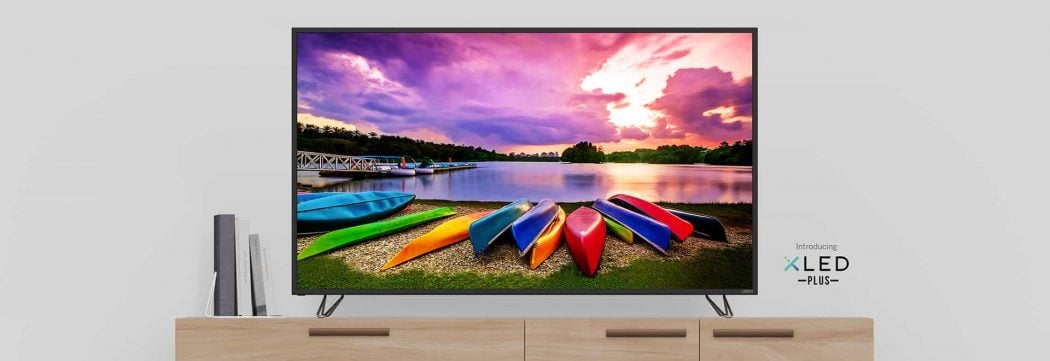Vizio SmartCast M-Series TV Review

This cord-cutter’s 4K display has Netflix, Hulu, Amazon, Chromecast and more built right into it, with a fantastic picture to boot.
Review disclosure: A Vizio SmartCast model M50-E1 was provided to groovyPost.com at no charge in order to facilitate review.
For years, I used the first flatscreen HDTV that I bought when I moved into my house. It’s exactly what I wanted at the time: something basic in the $500 range with HDMI inputs that can be mounted handsomely above my fireplace. Fast-forward a few years and I’m in a new house with a new handsome fireplace and I’m in the market for a TV again.
For me, there was good news.
I can go out and buy a TV in the $500 range today and it’ll be a vast upgrade to the TV that I bought years ago. In the interceding years since I bought my first HDTV, there have been a number of technological improvements, including 4K Ultra HD, built-in streaming apps and a host of other picture-enhancing features.
And that’s what I would’ve done, except I got even luckier: Vizio offered to provide me one of their new SmartCast M-Series TVs to review for groovyPost. So I did. And I like it a lot.
Let me tell you why.
The Vizio SmartCast M-series is an app-powered display with 4K ultra HD and HDR with Dolby Digital. It has Netflix, Hulu, Amazon, and other apps, plus a built-in Chromecast, making it a one-stop shop for cord-cutters looking to break into 4K.


Price: $599 and up from Best Buy
Strengths: Excellent picture for the price. Smooth and intuitive apps that cover all your bases for streaming TV shows and movies from the most popular services.
Weaknesses: Slightly thicker than average for a wall-mounted TV. The Smartcast mobile app doesn’t add much value.
Bottom-line: While not the cheapest 50-inch 4K TV you can find, the Vizio SmartCast has a great picture and a decent selection of apps. If you don’t have an Apple TV already, then this is a good way to get into cord-cutting.
Picture Quality: 4K, HDR, Dolby Engine, Refresh Rate


So, first I want to talk about the picture. On a TV, you might think this is the most important feature. But to me, it’s not—at least once you pass a certain threshold of quality. I’ll openly admit that I cannot tell the difference between a great picture and an excellent picture unless you put them side-by-side. And sometimes not even after that. The stuff that might bug a frequent TV watcher are things you might notice over a months or years of ownership. You won’t usually notice this in-store, especially since most displays will have their demo modes running, which always makes the TV look its best.
To that point, you can enable the store demo on your Vizio SmartCast M-series if you want to be reminded how much 4K matters. It truly is amazing. I remember pretending that I couldn’t tell the difference between standard definition and HDTV. I tried to do the same with 4K, but when you turn on the SmartCast store demo, the picture quality smacks you in the face. When I turn the TV on, it looks just like a window. I even got a little jumpy when the snakes and meat-eating big cat appeared on-screen.
But let’s be real.
A lot of the content that you watch right now will not be 4K. In fact, some of it might not even be HD. I treated myself to a few episodes of the original Seinfeld series. While the comedy holds up, the audio and picture are certainly dated, and no amount of display technology will change that.
That’s not to say that the Vizio SmartCast M-series doesn’t have some tricks up its sleeve. I started delving into the display settings on the TV and was quickly overwhelmed by all the options and parameters you can tweak. I tried a few, but I really don’t know what I’m doing. It’s sort of like being handed a digital SLR camera in manual mode. You may as well have just handed me a French horn. I don’t know how to work that thing.
That’s good news for people who do have a discerning eye for the nuances of an ultra-high quality picture. But for dummies like me, the SmartCast M-series does have some nice “point and shoot” equivalent picture features. These are enabled by default, and they do their best to make all content—be it SD, HD, or 4K—look it’s best. Here’s a quick overview of what the SmartCast M-series does, whether you realize it or not:
VIZIO XHDR Plus with support for Dolby Vision


According to Vizio, XHDR Plus offers “greater brightness and contrast, as well as a fuller palette of rich colors.” This is essentially the definition of HDR for TVs, which is different than photo HDR. What matters is that when studios produce HDR content, you won’t get the full experience unless you have a device that supports it. Dolby Vision HDR content is available on a number of Blu-ray titles as well as Netflix, Amazon Prime Video, and Vudu. When you watch Dolby Vision content, you’ll notice greater detail, better contrast management, and more balanced and nuanced colors.
The Vizio M-Series is one of the few TVs to support both Dolby Vision and HDR10. According to Dolby’s website, LG, Phillips, TCL, and Apple TV 4K are the only other companies with Dolby Vision other than Vizio.
VIZIO Ultra Color Spectrum


This feature is new to the M-Series of Vizio SmartCast TVs. The company claims that Ultra Color Spectrum technology renders “over 1 billion colors more than conventional TVs with Rec 709.” As someone who just recently learned that “indigo” was a color, I’ll take their word for it regarding the other 999,999,999 colors.
According to company reps, the color gamut is this close to P3 (which is the color gamut used in digital cinema). This means redder reds, greener greens, bluer blues and overall a more naturally vivid and color-saturated image.
VIZIO Xtreme Black Engine Plus


Okay, all joking aside, the way that TVs do or do not display black or dark content has always bugged me. I was sad to see plasma TVs fall off the map, partly because the word “plasma” sounds awesome, but also because it was widely known that they stomped the competition (at the time) in the way they displayed color and black levels. Whereas a plasma display could go truly black, the LCD TVs at the time left a washed out gray space where there should’ve been the abyss.
Backlit LED technology has improved greatly since plasma lost the TV war, but it still continues to be a struggle. The way the Vizio SmartCast meets the challenge is through local dimming. This means adjusting the brightness of the backlight in specific zones on the TV to account for the black areas and shadows in the picture. Some TVs will be edge-lit, which greatly limits the number of zones that can be adjusted like this. The Vizio SmartCast M-series is a full-array LED-backlit TV, which gives it more zones that it can control. 32 zones to be exact.
Refresh Rate
The refresh rate matters when there’s a lot of action and fast motion on the screen. That is, for watching sports or playing video games. On the box, you’ll see that the Vizio M-Series has an “effective refresh rate” of 120 Hz. What exactly does that mean?
Technically, it has a native refresh rate of 60 Hz, which is fairly standard. But Vizio is saying that its built-in processing technology boosts the refresh rate so what you see is equivalent to 120 Hz.
That may seem confusing, but every manufacturer has an advertised refresh rate that is above and beyond the native refresh rate. In terms of what you can actually see, the M-Series is pretty good. There is a slight motion trail for very fast-moving objects, but it’ll definitely do the job for watching a hockey game or playing video games. Only very discerning eyes will be able to tell the difference between the M-Series’ 120 Hz effective refresh rate and, say, the Vizio SmartCast P-Series’s 240 Hz effective refresh rate (i.e., 120 Hz native refresh rate).
Dimensions, Stand, and Wall-Mount
The Vizio SmartCast TV that I received is an M50-E1. It weighs 28.22 lbs without the stand.
It’s a 50-inch TV. Without the stand, it’s 44.0 x 25.61 x 2.68 inches. The stand adds about 2 inches of height and 6 inches of depth making it 44 x 27.98 x 8.70 inches. Without the stand, it weighs just 28.22 lbs, making it very manageable for wall-mounting. The dimensions and weight will vary for the larger size displays.


The 50-inch TV has a 200 x 200 mm hole pattern. The larger displays have 400 x 400 mm hole patterns.
In terms of thickness, I’d say it’s slightly above average. It’s not insanely thin like some of the new super expensive OLED TVs. But it’s definitely an improvement over my TV from six years ago. (Part of the extra thickness is due to the full array LED, which results in a little more depth than an edge-lit display.) The wall mount bracket you buy will have a big impact, too.


The hole pattern is a VESA standard 200 mm x 200 mm pattern and the screw size is M6. I didn’t need to know any of that to mount it, though, I just took my old wall-mount bracket, stuck it on my new TV and popped it up on the wall. I was pleased that the TV was a good deal lighter than my last TV.


The stand is simple, easy to install, and tastefully understated. Instead of a big honking base, it’s got two silver-colored legs that slide into slots in the bottom and get attached with two screws. It looks quite nice on the stand.
Inputs and Ports
Now, let’s talk about your inputs and outputs. Here’s what you get with the M-series Vizio SmartCast TV:
- HDMI ports – There 4 HDMI inputs, three on the back and one on the left-hand side. HDMI 1 is the HDMI ARC port, which lets your TV control your A/V receiver set-top box or gaming console and vice versa.
- Component inputs – The left-hand side has the five port YPbPr video component inputs and left and right audio inputs.
- Component outputs – The back has left and right component audio outs for hooking up a soundbar or speaker
- Optical output – The back also has an optical port for an optical/SPDIF audio device, like a home theater receiver
- Ethernet – There is an RJ-45 Ethernet port on the back.
- USB 2.0 – The USB 2.0 port on the side can be used to power your devices or display photos or play music or videos directly on the TV.


The back connection panel is recessed so the plugs can be inserted vertically. This helps if you’re trying to keep a low profile on a wall-mount. The cables that I used were a little too heavy duty for this and I had trouble getting my HDMI plugs angled in. Normal HDMI cables are a bit more flexible, though, and I don’t think most people will have this problem.


The power plug is on the opposite side and plugs in from the bottom as well. It’s thin and very low profile.
Apps and Connectivity


This is the remote that came with my M-Series display. If you have this one, you can upgrade for $6 by going to vizio.com/remote
So, let’s talk about what makes this a “smart” TV. The Vizio SmartCast is an internet-connected TV that lets you stream content from built-in apps like Netflix and Hulu or via Google ChromeCast. To that end, the Vizo SmartCast has a very lightweight “operating system” somewhat akin to what you’d find on a Roku device or Apple TV. You control the TV using the normal “dumb” remote (my preference) or the Vizio SmartCast mobile app.


Vizio SmartCast TVs now come with this remote, with dedicated app buttons.
The appeal of the Vizio SmartCast is that it lets you stream TV shows and movies without having to buy an Amazon Fire TV, Google Chromecast, Roku, or Apple TV separately. Of course, if you have one of these devices already, you can use it with your SmartCast. Your satisfaction with the SmartCast in lieu of an Apple TV or similar device will depend on your media consumption habits. If all you need is Netflix and Hulu, you’ll have everything you need. If you want to delve into the App Store and gaming, then you’ll still need to invest in another smart TV device.


SmartCast TVs have Netflix, Hulu, Amazon, and Chromecast built-in.
Internet and WiFi
The Vizio SmartCast is, of course, an internet-connected TV. You can connect using a wired Ethernet connection (RJ-45 on the back) or a wireless internet connection.
The WiFi adapter in the TV supports wireless AC, so it’s pretty speedy if you’re in range. When you’re connected to WiFi, the TV will show you your signal strength.
Fast internet connections are important since this is a 4K TV. For instance, Netflix recommends a connection of 25 Mb/s or faster for 4K ultraHD content—a minimum of 15 Mb/s is required to start a 4K stream. As a side note, because the SmartCast supports Dolby Vision, you can still get HDR content at less than 4K resolution if the network speed drops.
I tested out a wireless-N, wireless-AC, and wired Ethernet connection on the TV using the Test Connection function. I was alarmed when the Vizio built-in connection test gave me of just under 10 Mb/s for each connection. I tried it out on both WiFi and wired Ethernet a couple different times.
Fortunately, this seems to be an isolated bug—running the speed test in the Netflix app gives me speeds of 73 Mb/s on wireless-N, 91.5 Mb/s on wireless-AC, and about 88 Mb/s on wired Ethernet. I find it odd that the wired connection isn’t faster than my wireless-AC connection, but it could be something with my home network setup.


Left: Built-in Vizio network speed test. Right: Netflix app speed test (on TV)
But if you are considering upgrading to a new wireless-AC router, it’s likely worth it in the impending 4K world.
In this review, I keep on calling the Vizio SmartCast a TV, which is slightly inaccurate. The SmartCast does not have a built-in TV tuner for cable channels or over-the-air digital TV via antenna. This makes it technically a “display” rather than a television. All the content you get on your SmartCast display will be via one of the built-in apps, streamed via the built-in Chromecast function, the USB port, a set-top box, or another device via HDMI or component.
I can’t think of anywhere that still has coaxial cable service that doesn’t go through a set-top box first. But if you watch over-the-air broadcast television, you will have to buy a separate digital TV tuner box with HDMI out.
Built-in Apps
The Vizio SmartCast comes with all the streaming heavy hitters as stock apps: Netflix, Hulu, Amazon Prime Video, and Vudu. Other apps include Crackle, iHeartRadio, Xumo, and Fandango Now. It also has Pluto TV and Haystack.tv, which come about as close to watching live cable TV as it gets.
My main family room TV has an Apple TV hooked up to it already, but the SmartCast’s lineup of apps is a worthy addition for two big reasons: (1) Amazon Prime Video and (2) 4K Ultra HD support, neither of which are supported by the 4th Gen Apple TV I own.


Beyond that, I tried pretending I didn’t own the Apple TV and gave the SmartCast-only experience a whirl. I actually liked it quite a bit. I’ve been a cord-cutter for quite some time, so I admit that it’s been a few years since I’ve had the experience of plopping on the couch with a single remote and just “seeing what’s on.” But with the SmartCast, it sort of felt like I was doing that—except without paying $200+ a month for cable.
The native Netflix, Amazon, and Hulu apps are just as intuitive and speedy as my Apple TV, though the Vizio remote is obviously not as slick as the Siri remote. You also get a unified search that lets you find content across all the apps, which is very similar to Apple TV’s universal search.
As a sort of geeky aside, part of what makes SmartCast’s apps so speedy and smooth is that they are actually barely apps at all. Rather, they are cloud-based apps that use HTML5. This lets Vizio avoid a frequent downfall of app-based smart devices—instead of developing their own applications for their proprietary operating system that constantly need patches and updates (yet still remain behind the curve), they can leverage the cloud app model to keep your experience up-to-date. I had to read Vizio’s official documentation to find that out—it didn’t feel at all like I was using a glorified web browser, rather than a native app.
Vizio SmartCast App and Chromecast Support
Besides the conventional remote that comes with the SmartCast TV, you can play content to your TV using any mobile app that works with Google Chromecast or SmartCast’s mobile app. The SmartCast TV has a Chromecast built right into it, so it’s basically just like you had bought a separate Chromecast and had it plugged in at all times. For apps like YouTube, TuneIn, Pandora or any other app that’s not built-in to your SmartCast, the Chromecast feature is pretty dang handy. True, having Chromecast built-in is nominally only a $35 value (the price of buying a Chromecast on its own), but having it integrated into the display without having to switch inputs is quite nice. Also, because it’s integrated with the TV, you can stream HDR content right to your TV. The Chromecast software will also be updated on the same cycle as standalone Chromecast devices. I’d expect some sort of casting capability—be it Chromecast, AirPlay or something else—become standard in displays in the near future. Samsung TVs have something similar, but it only works with Samsung phones (sorry, iPhone users).


The Vizio Smartcast mobile app is somewhat of a relic, now that the SmartCast comes with a traditional remote and menus. It combines the features of the traditional remote and whatever you’d be able to do via a Chromecast app. It’s a fine app, but I don’t find myself using it that much. It might be useful if you want to browse featured content and live streams or manage your watchlist while watching else on the TV. The SmartCast app also has a convenient section called “Cast apps” which links you to all the apps that can stream content to your display. If you have the app, it’ll open it. If you don’t, it’ll take you to the app store. You can also manage your TV’s settings from the app. Overall, though, the SmartCast mobile app is far from essential.
Audio
There’s not much to say about the Vizio SmartCast’s built-in audio, but that’s true of all flatscreen TVs. As TVs get thinner and thinner, there’s just not enough room to put decent quality speakers into the unit. The expectation these days is that you’ll pair your flatscreen display with a sound bar or a home theater sound system.
That’s not to say that the built-in speakers on the Vizio SmartCast are unlistenable. I use the TV without a sound bar right now and it’s fine, albeit not exactly immersive and cinematic. There are a few settings on the TV that try to improve upon the inherently flat and tinny audio, like Surround Sound, Volume Leveling, and Equalizer, but they only go so far.


Since flat audio is par for the course, I’m not going to count this against the SmartCast.
Conclusion
The Vizio SmartCast M-Series is a very decent, all-around 4K TV. It has built-in apps for streaming, which means you can get 4K content on it without upgrading your Apple TV or Roku. If you are buying this as a second TV, say for the bedroom or a game room, its built-in apps, and Chromecast capabilities make it so you don’t have to buy a separate streaming box if you don’t want to.
In terms of the remote control and menu, the Vizio SmartCast 2017 models return to a traditional remote and on-screen menus. There is a SmartCast mobile app you can use on your phone or tablet, but the TV doesn’t require it, and it doesn’t come bundled with a tablet remote.
Overall, I’m impressed by what the Vizio SmartCast M-Series offers for the price. While far from the high-end displays that can cost thousands more, the M-Series gets you into the 4K realm with a decent amount of features and smart TV capability.
1 Comment








Phyllis Gresky
August 24, 2019 at 7:40 am
Does it matter if you have Android Samsung phone and tablet